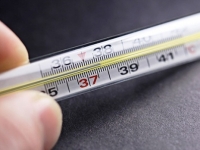our consultants
Temperature 37.2 – reason to consult a doctor: what will tell subfebrile
 A serious illness that can develop in the body imperceptibly for the person himself can be “declared” by a slightly increased body temperature. Low-grade fever (37-37.5 ° C) can last for several weeks or months, but does not bother the person. Meanwhile, subfebrile condition can be a symptom of a sluggish inflammatory process or a serious disease.
A serious illness that can develop in the body imperceptibly for the person himself can be “declared” by a slightly increased body temperature. Low-grade fever (37-37.5 ° C) can last for several weeks or months, but does not bother the person. Meanwhile, subfebrile condition can be a symptom of a sluggish inflammatory process or a serious disease.
Body temperature: norm and deviation
So what is the norm and deviation from it, if we are talking about the temperature of the human body? The classic normal temperature of a healthy person is 36.6 ° C. However, these indicators are not always stable and may change under the influence of a number of factors. And this does not mean that something is wrong with you. Temperatures can vary from 35.5 to 37.4 ° C due to the influence of climate, biological rhythms, and time of day. Continue reading
What is botulism?
 Botulism is an acute toxic and infectious disease in which severe damage to the human nervous system occurs. The causative agent of botulism is in the intestine of animals, birds, fish, and from there it gets back to the soil and water. Bacteria of botulism, called anaerobes, live exclusively in places where there is no air, and therefore badly washed, uncleaned, hermetically packaged food is extremely dangerous.
Botulism is an acute toxic and infectious disease in which severe damage to the human nervous system occurs. The causative agent of botulism is in the intestine of animals, birds, fish, and from there it gets back to the soil and water. Bacteria of botulism, called anaerobes, live exclusively in places where there is no air, and therefore badly washed, uncleaned, hermetically packaged food is extremely dangerous.
The main danger of botulism is that the toxin blocks the respiratory function of a person, the lack of oxygen provokes the disruption of the work of all internal organs. Botulinum toxin is the most potent biological poison in the world, it is hundreds of thousands times more dangerous than poison, for example, rattlesnake. However, it quickly loses its harmful properties during heating and boiling. Continue reading
Bitterness in mouth, heartburn and abdominal pain: how to suspect bile reflux
 Problems in the biliary tract often have characteristic symptoms. Most often, the reflux of bile in the stomach and esophagus occurs during the development of gastroduodenal reflux: this condition occurs with diseases of the stomach, liver, biliary tract and duodenum, or with improper feeding and overeating. Do not be afraid of many incomprehensible medical terms, but you should understand what is behind them and why unpleasant symptoms begin to bother.
Problems in the biliary tract often have characteristic symptoms. Most often, the reflux of bile in the stomach and esophagus occurs during the development of gastroduodenal reflux: this condition occurs with diseases of the stomach, liver, biliary tract and duodenum, or with improper feeding and overeating. Do not be afraid of many incomprehensible medical terms, but you should understand what is behind them and why unpleasant symptoms begin to bother.
Why bile enters the stomach
Gastroduodenal reflux is not a disease itself, but a symptom that indicates a problem in the digestive organs. Continue reading



